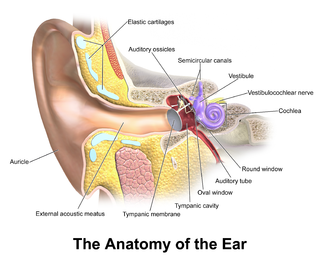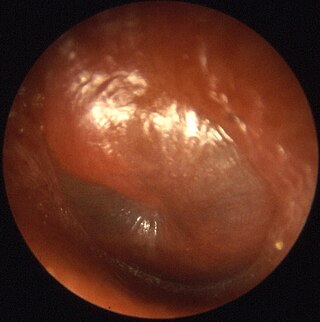
In the anatomy of humans and various other tetrapods, the eardrum, also called the tympanic membrane or myringa, is a thin, cone-shaped membrane that separates the external ear from the middle ear. Its function is to transmit sound from the air to the ossicles inside the middle ear, and then to the oval window in the fluid-filled cochlea. Hence, it ultimately converts and amplifies vibration in the air to vibration in cochlear fluid. The malleus bone bridges the gap between the eardrum and the other ossicles.

Otitis media is a group of inflammatory diseases of the middle ear. One of the two main types is acute otitis media (AOM), an infection of rapid onset that usually presents with ear pain. In young children this may result in pulling at the ear, increased crying, and poor sleep. Decreased eating and a fever may also be present. The other main type is otitis media with effusion (OME), typically not associated with symptoms, although occasionally a feeling of fullness is described; it is defined as the presence of non-infectious fluid in the middle ear which may persist for weeks or months often after an episode of acute otitis media. Chronic suppurative otitis media (CSOM) is middle ear inflammation that results in a perforated tympanic membrane with discharge from the ear for more than six weeks. It may be a complication of acute otitis media. Pain is rarely present. All three types of otitis media may be associated with hearing loss. If children with hearing loss due to OME do not learn sign language, it may affect their ability to learn.

Conductive hearing loss (CHL) occurs when there is a problem transferring sound waves anywhere along the pathway through the outer ear, tympanic membrane (eardrum), or middle ear (ossicles). If a conductive hearing loss occurs in conjunction with a sensorineural hearing loss, it is referred to as a mixed hearing loss. Depending upon the severity and nature of the conductive loss, this type of hearing impairment can often be treated with surgical intervention or pharmaceuticals to partially or, in some cases, fully restore hearing acuity to within normal range. However, cases of permanent or chronic conductive hearing loss may require other treatment modalities such as hearing aid devices to improve detection of sound and speech perception.

Ear pain, also known as earache or otalgia, is pain in the ear. Primary ear pain is pain that originates from the ear. Secondary ear pain is a type of referred pain, meaning that the source of the pain differs from the location where the pain is felt.

Otitis is a general term for inflammation in ear or ear infection, inner ear infection, middle ear infection of the ear, in both humans and other animals. When infection is present, it may be viral or bacterial. When inflammation is present due to fluid build up in the middle ear and infection is not present it is considered Otitis media with effusion. It is subdivided into the following:

An otoscope or auriscope is a medical device which is used to look into the ears. Health care providers use otoscopes to screen for illness during regular check-ups and also to investigate ear symptoms. An otoscope potentially gives a view of the ear canal and tympanic membrane or eardrum. Because the eardrum is the border separating the external ear canal from the middle ear, its characteristics can be indicative of various diseases of the middle ear space. The presence of earwax (cerumen), shed skin, pus, canal skin edema, foreign body, and various ear diseases can obscure any view of the eardrum and thus severely compromise the value of otoscopy done with a common otoscope, but confirm the presence of obstructing symptoms.
Hearing loss with craniofacial syndromes is a common occurrence. Many of these multianomaly disorders involve structural malformations of the outer or middle ear, making a significant hearing loss highly likely.
Pseudomonas otitidis is a Gram-negative bacterium that causes otitis. The type strain is ATCC BAA-1130.
The pneumatic otoscope is the standard tool used in diagnosing otitis media. In addition to the pneumatic (diagnostic) head, a surgical head also is useful. The pneumatic head contains a lens, an enclosed light source, and a nipple for attachment of a rubber bulb and tubing. The head is designed so that when a speculum is attached and fitted snugly into the patient’s external auditory canal, an air-tight chamber is produced. In some cases, the addition of a small sleeve of rubber tubing at the end of the plastic speculum or use of a rubber-tipped speculum helps to avoid trauma and improve the air-tight seal. Gently squeezing and releasing the rubber bulb in rapid succession permits observation of the degree of eardrum mobility in response to both positive and negative pressure.

Otitis externa, also called swimmer's ear, is inflammation of the ear canal. It often presents with ear pain, swelling of the ear canal, and occasionally decreased hearing. Typically there is pain with movement of the outer ear. A high fever is typically not present except in severe cases.
Staphylococcus schleiferi is a Gram-positive, cocci-shaped bacterium of the family Staphylococcaceae. It is facultatively anaerobic, coagulase-variable, and can be readily cultured on blood agar where the bacterium tends to form opaque, non-pigmented colonies and beta (β) hemolysis. There exists two subspecies under the species S. schleiferi: Staphylococcus schleiferi subsp. schleiferi and Staphylococcus schleiferi subsp. coagulans.
Alloiococcus otitis is a species of bacteria first isolated from human middle-ear fluid, the type species of its monotypic genus. The type strain is NCFB 2890.
Corynebacterium otitidis is a coryneform Gram-positive bacterium first isolated from patients with otitis media.
Gordonia is a genus of gram-positive, aerobic, catalase-positive bacterium in the Actinomycetota, closely related to the Rhodococcus, Mycobacterium, Skermania, and Nocardia genera. Gordonia bacteria are aerobic, motile, and non-sporulating. Gordonia is from the same lineage that includes Mycobacterium tuberculosis. The genus was discovered by Tsukamura in 1971 and named after American bacteriologist Ruth Gordon.. Many species are often found in the soil, while other species have been isolated from aquatic environments. Gordonia species are rarely known to cause infections in humans.
Gordonia araii is a Gram-positive and aerobic bacterium from the genus of Gordonia which has been isolated from human sputum in Japan.
Gordonia cholesterolivorans is a bacterium from the genus Gordonia which has been isolated from sewage sludge from a sewage treatment plant in Ciudad Real in Spain. Gordonia cholesterolivorans has the ability to degrade cholesterol.
Gordonia effusa is a bacterium from the genus Gordonia which has been isolate from human sputum in Japan.
Gordonia humi is a Gram-positive and non-spore-forming bacterium from the genus Gordonia which has been isolated from soil near the mushroom Agaricus brasiliensis in Taiwan.
Gordonia iterans is a bacterium from the genus Gordonia which has been isolated from a patient with pneumonia.
Gordonia sihwensis is a Gram-positive and nitrate-reducing bacterium from the genus of Gordonia which has been isolated from an autotrophic denitrification reactor in Sihwa in Korea.





